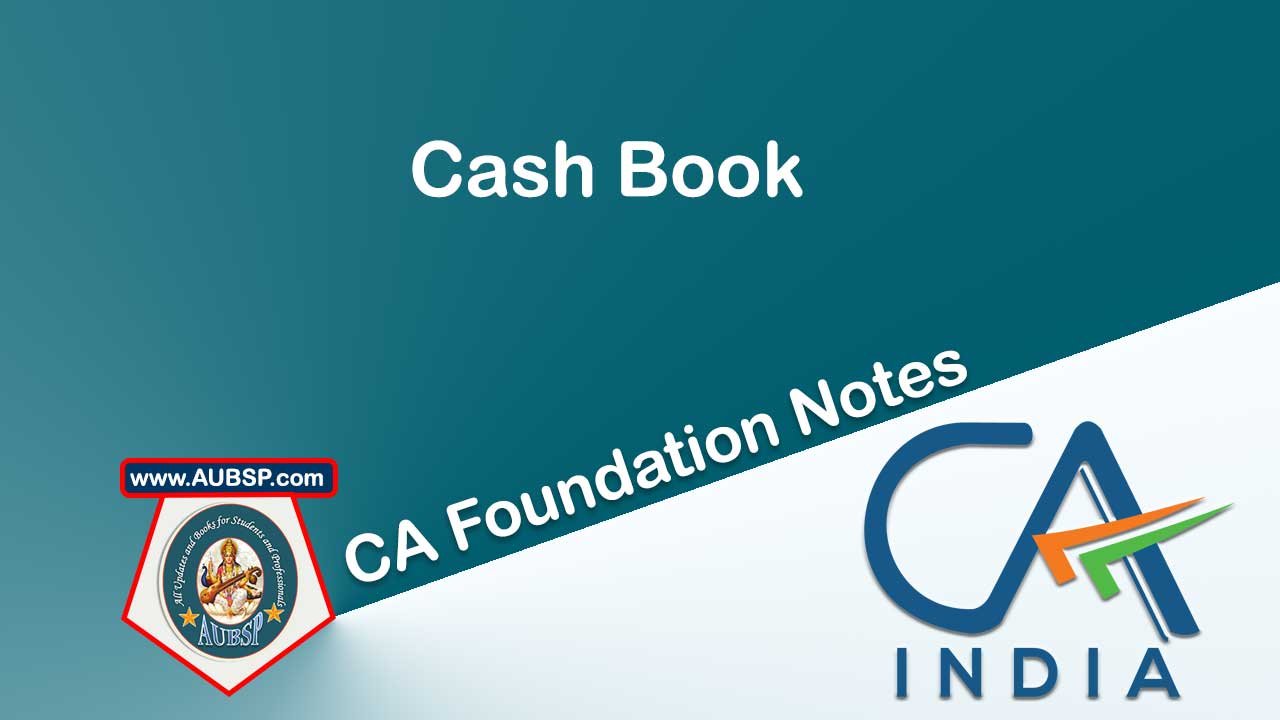This unit provides a comprehensive overview of the Cash Book in accounting, highlighting its dual role as both a subsidiary and principal book. It explains the structure and preparation of different types of cash books—Simple, Two-column (Cash + Discount/Bank), and Three-column (Cash + Bank + Discount)—along with practical illustrations.
The unit covers contra entries, cheque handling, and posting rules, and introduces the Petty Cash Book maintained under the Imprest System for managing small, frequent payments efficiently. It also discusses the accounting treatment for sales via credit and debit cards, emphasizing clarity, control, and ease of recording in financial transactions.
UNIT 5: CASH BOOK – Summary Notes
Learning Outcomes
After studying this unit, you will be able to:
- Understand Cash Book as both a subsidiary and a principal book.
- Prepare Simple, Two-column, and Three-column Cash Books.
- Comprehend the Imprest System of Petty Cash.
- Record and post entries from Petty Cash Books.
- Understand entries for credit/debit card sales.
5.1: Cash Book – Subsidiary and Principal Book
- It records cash and bank transactions.
- Serves dual role:
- Subsidiary book: Records original transactions.
- Principal book: Functions as Cash A/c and Bank A/c.
- No separate ledger needed for cash/bank.
5.2: Types of Cash Book
Simple Cash Book
- One column each on debit (receipts) and credit (payments) side.
- Balancing:
- Receipts > Payments → Balance is “By Balance c/d”.
- Brought forward as “To Balance b/d”.
Two-Column Cash Book
- Two columns: Cash + Discount or Cash + Bank.
- Discount Allowed → Debit side (loss).
- Discount Received → Credit side (gain).
- Discount columns are totalled, not balanced.
- Posting:
- Discount Allowed → Debit Discount A/c.
- Discount Received → Credit Discount A/c.
Three-Column Cash Book
- Columns: Cash + Bank + Discount on both sides.
- Contra Entries:
- Internal cash-bank transfers.
- Marked with “C” in L.F. column.
- No ledger posting needed.
- Rules:
- Deposit: Dr. Bank A/c, Cr. Cash A/c.
- Withdrawal: Dr. Cash A/c, Cr. Bank A/c.
- Cheque Handling:
- Received → First in Cash column.
- If deposited later → Contra entry to Bank.
- Dishonoured cheques entered on credit side of Bank column.
- Endorsement → Credit side of Bank column.
5.3: Posting Entries from Cash Book
- Receipts (Debit side) → Credit the respective A/cs.
- Payments (Credit side) → Debit the respective A/cs.
- Discounts:
- Totals posted to Discount A/c.
5.4: Petty Cash Book
Why Petty Cash Book?
- Avoid overburdening the main cash book with small payments.
- Managed by a Petty Cashier.
Imprest System
- Fixed sum given at start of period.
- Reimbursed for actual payments at end of period.
- Maintains consistent opening balance.
Petty Cash Book Structure
- Columns for: Date, Voucher No., Particulars, Amounts by Type (e.g. Conveyance, Cartage, Wages).
- Analysis columns help identify payment nature for posting.
Posting
Two options:
- Direct ledger posting from total of columns.
- Journal entry → Debiting expense accounts, crediting Petty Cash.
5.5: Sales via Credit/Debit Cards
- Equivalent to cash sales.
- Bank charges commission (1%-4%).
- Accounting Entries:
Bank A/c Dr.To Sales A/cCommission A/c Dr.To Bank A/c
Quick Tips & Tricks
True/False Key Points
- Cash Book is both subsidiary and principal book – ✅ True
- Two-column may have Cash + Discount OR Cash + Bank – ✅ True
- Discount column is NOT balanced, only totalled – ✅ True
- Trade discounts are NOT recorded in Cash Book – ✅ True
- Contra entries only for books with both cash & bank columns – ✅ True
- Overdraft shown as opening credit balance in bank column – ✅ True
MCQs Summary
| Q | Answer |
|---|---|
| 1 | (b) Debit of the Discount Allowed A/c |
| 2 | (a) Subsidiary book, principal book |
| 3 | (c) Petty Cash Column |
| 4 | (b) Three-column Cash Book |
| 5 | (c) All cash receipts and payments |
| 6 | (c) An asset |
| 7 | (a) In the Cash Book |
Theory Recap
Q1: Is Cash Book Subsidiary or Principal?
- Acts as both.
- Records transactions (subsidiary) and serves as ledger for cash/bank (principal).
Q2: Types of Cash Book
- Simple
- Two-Column (Cash + Discount/Bank)
- Three-Column (Cash + Bank + Discount)
- Petty Cash Book (Imprest System)
Q3: Advantages of Three-Column Cash Book
- Eliminates separate Bank/Cash A/cs.
- Reduces errors.
- Instant access to balances.
Sample Journal Entry from Petty Cash
Conveyance A/c Dr. 6.50
Cartage A/c Dr. 9.50
Stationery A/c Dr. 6.00
Postage A/c Dr. 12.00
Wages A/c Dr. 6.00
Repairs A/c Dr. 15.00
General Expenses Dr. 5.00
To Petty Cash A/c 60.00
FAQs on Cash Book
Q1. What is a Cash Book in accounting?
A Cash Book is a financial journal that records all cash and bank transactions. It functions both as a subsidiary book (book of original entry) and a principal book (like a ledger for cash/bank accounts).
Q2. Why is the Cash Book considered both a subsidiary and principal book?
Because it records original transactions like a journal (subsidiary), and also acts as the Cash and Bank ledger (principal), with balances used directly in the trial balance.
Q3. What are the main types of Cash Books?
- Simple Cash Book
- Two-column Cash Book (Cash + Discount or Cash + Bank)
- Three-column Cash Book (Cash + Bank + Discount)
- Petty Cash Book (Imprest System)
Q4. What is a Simple Cash Book?
A cash book with one column on each side to record only cash receipts and payments.
Q5. How is a Simple Cash Book balanced?
Debit (receipts) total is compared to credit (payments); the difference is carried forward as “Balance c/d”.
Q6. Are credit transactions recorded in a Simple Cash Book?
No. Only cash transactions are recorded.
Q7. What does a Two-column Cash Book include?
It includes two columns on each side: typically Cash + Discount or Cash + Bank.
Q8. Are discount columns in the Cash Book balanced?
No. They are only totalled, not balanced. Totals are transferred to the Discount A/c in the ledger.
Q9. How is discount treated in the books?
- Discount Allowed → Debit Discount A/c
- Discount Received → Credit Discount A/c
Q10. What are the columns in a Three-column Cash Book?
Cash, Bank, and Discount columns on both debit and credit sides.
Q11. What is a Contra Entry?
A transaction involving both cash and bank (e.g., cash deposited to bank), recorded on both sides and marked with “C” in the L.F. column.
Q12. Is a Contra Entry posted to the ledger?
No. It is self-contained within the Cash Book and not posted.
Q13. How are dishonoured cheques recorded?
- If received cheque is dishonoured → Credit Bank column
- If issued cheque is dishonoured → Debit Bank column
Q14. What if a cheque received is endorsed?
It’s credited to the Bank column (if previously debited); otherwise, no separate entry needed if endorsed on the same day.
Q15. What is a Petty Cash Book?
A book used to record small cash payments like conveyance, postage, cartage, etc., managed by a petty cashier.
Q16. What is the Imprest System of Petty Cash?
A system where a fixed amount is given at the start of a period and reimbursed at the end based on payments made, restoring the original balance.
Q17. What are the key advantages of a Petty Cash Book?
- Saves the main cashier’s time
- Reduces workload in the main Cash Book
- Controls minor expenditures efficiently
Q18. How are entries from the Petty Cash Book posted?
- Either post totals of columns directly to respective accounts
- Or pass a single journal entry debiting all expenses and crediting Petty Cash
Q19. How are receipts posted from the Cash Book?
Credit the respective ledger accounts (e.g., Sales A/c, Debtors A/c).
Q20. How are payments posted from the Cash Book?
Debit the respective accounts (e.g., Purchases A/c, Creditors A/c).
Q21. What happens to the discount columns?
Total of Discount Allowed (debit side) is debited to Discount A/c;
Total of Discount Received (credit side) is credited to Discount A/c.
Q22. How are credit/debit card sales treated in accounting?
They are treated as cash sales. Commission is charged by the bank and treated as an expense.
Q23. What are the journal entries for credit/debit card sales?
Bank A/c Dr.→To Sales A/cCommission A/c Dr.→To Bank A/c
Q24. How is bank commission on card sales handled?
It is debited to the Commission A/c (treated as an expense).
Q25. Can a Cash Book show a credit balance?
Cash column cannot—cash can’t be negative. But the Bank column can show a credit balance (i.e., overdraft).
Q26. Is it necessary to maintain separate cash and bank ledgers if a Cash Book is kept?
No. Cash Book already acts as both Cash and Bank Account.
Q27. What is recorded in the sundries column of Petty Cash Book?
Infrequent or miscellaneous payments not falling under defined heads.
Q28. Where is cash sales recorded?
In the Cash Book, under the debit side.
Q29. Are trade discounts recorded in the Cash Book?
No. Only cash discounts are recorded.
Q30. What is the difference between trade and cash discount?
- Trade Discount: Given at time of sale, not recorded.
- Cash Discount: Given for early payment, recorded in books.
Q31. How is opening overdraft in bank shown in Cash Book?
As a credit balance in the Bank column.
Q32. Can Cash Book be used to prepare trial balance?
Yes, since it contains balances of Cash and Bank.
The Cash Book serves as both a subsidiary and principal book in accounting, consolidating cash and bank transactions. This unit delves into the various types of Cash Books—Simple Cash Book, Two-column Cash Book, and Three-column Cash Book—each designed to handle different transaction complexities, including the recording of discounts and bank transactions.
The Petty Cash Book, using the Imprest System, is employed to manage small expenses, enhancing efficiency and control in large businesses. Key concepts such as contra entries and bank charges for credit/debit card sales are also discussed, highlighting their role in reducing errors and ensuring proper financial management. By mastering the techniques of Cash Book preparation and posting, individuals can maintain accurate financial records, simplifying the accounting process.



Leave a Reply
You must be logged in to post a comment.